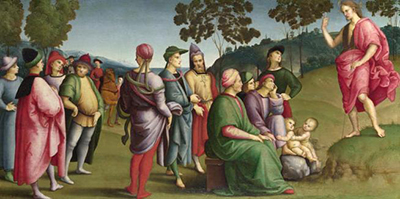Raphael is a well-known artist and architect of the High Renaissance with plenty of admirable work. Among the many popular artworks by this talented artist is Saint John the Baptist Preaching which was completed in the year 1505.
This artwork is one of the two pictures that formed Raphael's altarpiece and the piece was set below the image of Saint John in the principal altarpiece. From this painting, Saint John the Baptist is seen preaching to a group of people including men, women and even children. There was a depiction of Mary Mother of Jesus' betrothal beneath the Virgin and Child and below Saint Nicholas one of his miracles. Unfortunately, these paintings did not survive, and the Saint John Preaching was the only panel that made it out of the whole altarpiece by Raphael. The painting has a size of 26.2 centimetres by 52 centimetres on a Poplar support.
The artwork was first set on the lower part of the platform on which the altar is placed. This was known as the Predella of the altar of Ansidei Madonna located in the Church of Saint Florrenzo in the city of Perugia. The National Gallery London are the current owners of this painting which they bought in the year 1983, and it was since then given NG6480 as the Accession number. The Oil medium on poplar was used by the while painting this artwork hence giving the painting the high-quality and proper display of pigment which was later analysed by scientists at the National Gallery London.
According to the Scientific analysis of the pigment seen in the painting, the sky blue pigment which depicts the sky is as a result of a mixture of natural ultramarine and white then painted over a combination of azurite with white. The foliage of the tree is an underpaint of a mix of lead-tin, yellow ochre and verdigris. The blue drapery of the women on the far left is an ultramarine painted over azurite. The landscape is an underpaint of azurite, lead white, yellow ochre and lead-tin yellow on the lower layer, and the upper layer is a mixture of verdigris and lead-tin yellow.
The lower brownish parts where the Saint stands is also an underpaint of azurite, lead-tin yellow, lead white and yellow ochre just like the landscape but with additional translucent glazes of yellow. The halo that Saint John is seen wearing on his head is gold while the green drapery of the man sitting in the crown is verdigris. The red cloak of the man on the left is a mixture of red lake with some vermilion highlighted with little white. Lastly, the mauve coloured hose of the man in the red cloak is a mixture of red lake, ultramarine and lead white in a double layer.
The results of the above pigment analysis of this painting by Raphael have been published in the website of Raphael Research Project of the National Gallery London. The investigation results include all the microscopic cross-sections images, x-ray images as well as the infrared images.




